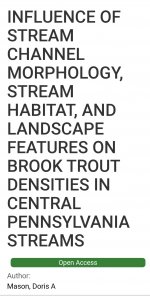So, when looking at blue lines, what do you consider an "access point"? I've always figured bridges were fair game. What about where a creek is tightly paralleled by the road?
To me, an access point is anywhere I can get to a creek from a road since I will be driving as close as possible to said creek before embarking.
That can be a bridge, a parallel road, RR tracks or a trail head. In the case of roads, I always survey the elevation change on a topo map between the road and the stream. As folks that fish in Tioga & Potter know, you need to choose your paths to the creek from a road wisely. What looks like a nearby road on a map can be almost a sheer drop.
You also need to plan your exit, especially if you plan to fish until dark. I always look for an easy way off a stream while it is still light, hopefully with a manageable grade back to a road, trail or my access point.
Again thinking of places in North-Central PA, there are some places I frequent that used to take me over an hour and a half of wading back down the same stretch I fished because, where I ended up when I quit was in such a deep canyon that there was NO WAY to hike out. Now I plan my outings by skipping those sections unless I have enough time to fish up to a place where I can get off easily.
As far as permission goes, nobody needs to be reminded that access to the little waters in PA is a privilege, not a right! Assume anything else and expect more posting and less access. Expect nothing and do whatever you can to ask BEFORE fishing or move on elsewhere and you will be OK.
Think of it as your property and how you would want someone to respect that. You wouldn't want to come home and find someone having a picnic on your front lawn or borrowing you lawnmower without asking, would you...?
...why is fishing any different in the don't be a ******** arena?
Case in point: A Class A runs through my property. My property ISN'T presently posted. If someone came up to my house and asked me if they could fish, I most likely would say yes, give them a beer and join them.
If I stumbled upon someone fishing who espoused the "implied consent" BS, I'd kick them off and put up signs the same day and patrol going forward.





